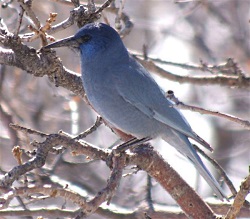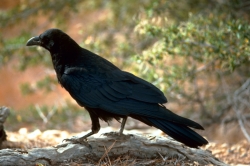Download Pre-broadcast audio

Courtesy & © Rob Soto Used with permission
I have spent many hours on many days for many years speaking with ravens. It’s not easy though to learn a new language, and their patience with my workshopping is not high on their honey-do list. Nevertheless, I work on it every chance I get, and they humor me with free lessons and bountiful harvests of humility.
Before you can speak though, you must first listen. Hear what dialect they speak because they do differ. Do their calls sound like mercury dropping into a still pail of clear cool water, or a porcupine purring as a trusted one scratches an old itch with gentle trepidation? Perhaps this raven growls in fours, fives, and sevens. Perhaps it mimics the locking door beeps it learned from the untrusting cars at a dusty desert gas station. Any way they call though, don’t forget that they do so without lips. When you call back, remember to curl yours back to show your own black beak. It also helps if you look friendly, so maybe give them a smile, too.
What I’ve learned from years speaking with ravens, is that they enjoy engaging with us wilderness tourists just like how I imagine the French mock Americans who ask simple questions through their noses while in berets at the Eiffel Tower. The ravens, still like how I imagine the French, will chirp or croak or clop back at you, but always faster than you thought you had tacitly agreed to. Can’t you hear that I’m not a native speaker, and can’t you respect that I’m at least trying? Oh, they can and they don’t. That’s the humor.
Sometimes they’ll throw new words your way, too, and always with a gleam in their eye. Just as you’re learning how to hock “hello,” they’ll pop quiz you and bleet back, “howdy,” “hey there,” and “greetings puny earthings,” just to smile to themselves at your dense bones and plucked, useless wings. To you, they may all sound like new noises. To them, they’re new jokes. Even when they start to cackle at my attempts, in time I’ve learned to cackle at myself, too. The lessons go on.
So next time you’re high in the mountains or deep in the desert and find yourself startled by a raven asking what life is like from way down there on the target range, listen first. Hear for the intonation, the subtleties in rhythm and iridescent syncopation, and their sandstone timbre. Then simply repeat after them. Curl your lips back, clench your larynx, and croak. Taste a new language. Harness the moment as a shared moment. Allow yourself to be the wild echo of a wild raven. Soon, you’ll find that when you speak the right language, ravens will give your own wild echo back. So now the question arises: will allow yourself to continue learning to speak with ravens, or will you simply settle to talk amongst your fellow puny earthlings?
I’m Patrick Kelly, and I’m Wild About Utah
Credits:
Images: Images Courtesy & Copyright Rob Soto, Artist, all rights reserved
Audio: Contains audio courtesy Davyd Betchkal, NPS Audio
Text: Patrick Kelly, Director of Education, Stokes Nature Center, https://logannature.org
Included Links: Lyle Bingham, Webmaster, WildAboutUtah.org
Additional Reading
Boling, Josh, Josh’s Raven Encounter, Wild About Utah, June 11, 2018, https://wildaboututah.org/joshs-raven-encounter/
Boling, Josh, The Language of Ravens, Wild About Utah, February 19, 2018, https://wildaboututah.org/language-of-ravens/
Strand, Holly, Crow vs. Raven, September 15, 2011, Wild About Utah, https://wildaboututah.org/crow-vs-raven/
Strand, Holly, Cache and Retrieve, Wild About Utah, January 19, 2012, https://wildaboututah.org/cache-and-retrieve/
Kelly, Patrick, As a Child I Loved Nature, Wild About Utah, April 29, 2019, https://wildaboututah.org/as-a-child-i-loved-nature/
Raven Sounds:
- Max Ushakov, A huge raven making weird sounds in front of a crowd at the Tower of London., YouTube.com, July 14 2016, https://www.youtube.com/watch?v=l7jgjovK5lY
- ESL and Popular Culture, Raven ~ bird call, YouTube.com, Dec 12, 2012, https://www.youtube.com/watch?v=DDv_PlrBg14
Common Raven, Animals, National Geographic, https://www.nationalgeographic.com/animals/birds/c/common-raven/
Bird Note, How to Tell a Raven From a Crow, Oct 22, 2012, Audubon, https://www.audubon.org/news/how-tell-raven-crow
https://video.nationalgeographic.com/video/raven_intelligence
Ravens, Arches National Park, National Park Service – NPS.gov, Last updated: February 8, 2017, https://www.nps.gov/arch/learn/nature/ravens.htm
Common Raven, Zion National Park, National Park Service – NPS.gov, Last updated: January 31, 2016 https://www.nps.gov/zion/learn/nature/raven.htm




